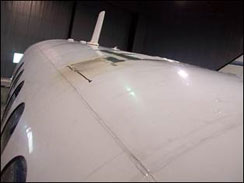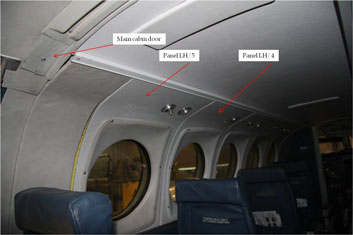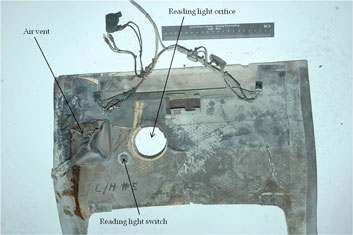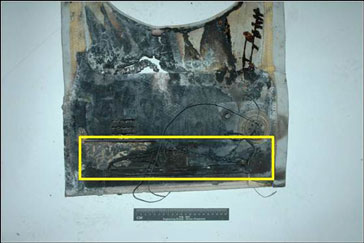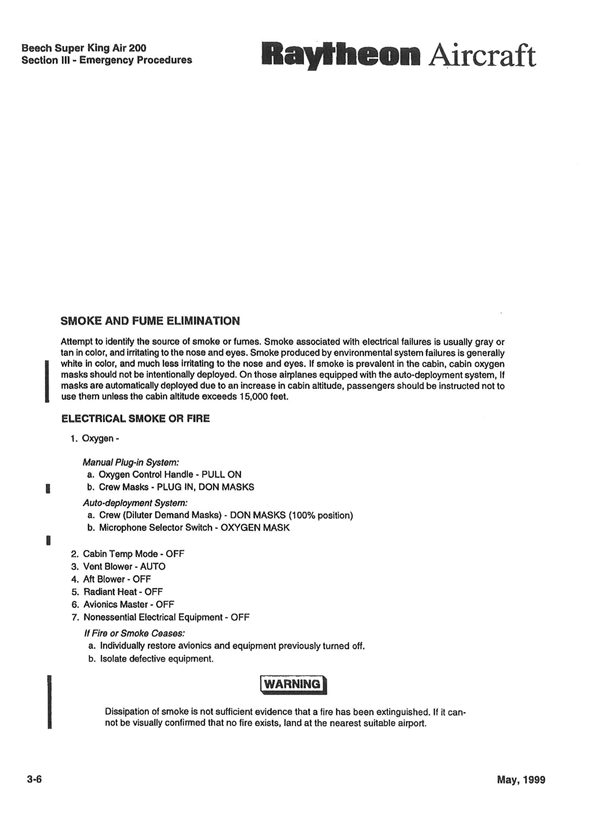Cabin Fire
Skyjet M.G. Inc.
Beech 200, C-FSKQ
Sept-Îles Airport, Québec
The Transportation Safety Board of Canada (TSB) investigated this occurrence for the purpose of advancing transportation safety. It is not the function of the Board to assign fault or determine civil or criminal liability. This report is not created for use in the context of legal, disciplinary or other proceedings. See Ownership and use of content. Masculine pronouns and position titles may be used to signify all genders to comply with the Canadian Transportation Accident Investigation and Safety Board Act (S.C. 1989, c. 3).
Summary
The Beech 200 (registration C-FSKQ, serial number BB-99) operated by SkyJet M.G. Inc., with 2 pilots and 4 passengers on board, conducted a medical evacuation flight according to instrument flight rules, between La Romaine Airport and Sept-Îles Airport in Quebec. While the aircraft was approximately 5 nautical miles from landing on Runway 09 at Sept-Îles, one of the passengers informed the flight crew that there was smoke in the cabin. The crew switched off the fluorescent lights in the cabin, the ordinance lights and the two air bleed systems. The smoke appeared to dissipate. The aircraft touched down at 1239, Eastern Standard Time, and taxied to the company's facilities. Once the aircraft came to a stop, some smoke reappeared. Emergency services were alerted. The crew was unable to locate the source of the fire until it became visible from outside the cabin, on the top left of the fuselage. The crew extinguished the fire using portable fire extinguishers. There were no injuries. The aircraft was significantly damaged.
Factual information
The flight crew was certified and qualified for the flight in accordance with existing regulations.
At approximately 1135, Footnote 1 the aircraft took off from La Romaine Airport en route to the Sept-Îles Airport, Quebec (CYZV). On board were 3 medical personnel and 1 patient on a stretcher. The approximately 1 hour flight was uneventful until the aircraft prepared for final approach. At that time, the ceiling was broken with a layer of cloud at 900 feet above ground level (agl) and another at 2000 feet agl. Ground visibility was 2 statute miles in low freezing drizzle and fog.
When the aircraft was approximately 5 nautical miles from the threshold of Runway 09, one of the passenger got up and informed the crew that there was smoke in the cabin. The crew switched off the fluorescent cabin lights and the ordinance sign lights Footnote 2. The air bleed systems of both engines were also switched off. The crew did not declare an emergency. The first officer, who was at the controls of the aircraft, handed them over to the captain and proceeded to the cabin to assess the situation. He observed the presence of grey smoke, which appeared to be dissipating.
The first officer returned to his seat, and the aircraft landed safely. At the company's facilities, the medical personnel exited the aircraft. At that time, the crew again spotted smoke, but was unable to locate the source. With the help of ambulance attendants, the patient was removed from the aircraft as quickly as possible. Meanwhile, the first officer called the flight service specialist via cell phone to inform him of the situation. He then dialed 911 and requested the assistance of municipal firefighters. The crew shut the main door of the aircraft. The general location of the fire was observed from the exterior, where paint on the left side of the fuselage was burning. The crew again opened the main door and discharged 3 portable fire extinguishers. When the Sept-Îles municipal firefighters arrived, the fire was under control.
The crew did not follow the emergency procedures for smoke and fume elimination. These procedures require that, as a first step, crew members read a paragraph of text to help them identify the source of smoke. Among other things, this paragraph states that smoke associated with electrical failures is usually grey, and smoke associated with air-conditioning system failure is usually white. The emergency procedures in case of smoke or electrical fires covers 7 points (see Appendix A). The 1st point requires the crew members to don oxygen masks in order to prevent them from inhaling smoke, after which they must proceed to isolate electrical systems that could be the source of smoke or fire. With the exception of the 7th point, that says to turn off non‑essential electrical equipment, none of the points refer directly to isolating the lights in the cabin.
The Beech 200 has 2 switches in the cockpit that activate the cabin lights.
- The fluorescent lighting system is controlled by a 3-position switch, i.e. low intensity in the down position, high intensity in the up position and OFF in the centre position.
- Another 3‑position switch controls the ordinance sign lights, i.e. FASTEN SEATBELTS in the up position, NO SMOKING in the down position, and OFF in the centre position.
The 6th point states to turn off the Avionics Master switch of the avionics system, which would cut electrical power to the navigational aids used for the approach. In the cockpit, there is no switch dedicated to the reading lights in the cabin, as they are operated separately by each passenger. A 10‑amp circuit "Cabin" breaker, located on the right side of the cockpit, controls cabin lighting. The crew did not pull the circuit breaker, and the checklist does not mention such action. Nothing indicates that the circuit breakers tripped following the appearance of smoke and fire. The emergency procedures include a warning as follows: "Dissipation of smoke is not sufficient evidence that a fire has been extinguished and that if it impossible to visually confirm that no fire exists, land at the nearest suitable airport."
The C-FSKQ was manufactured in 1976, and had accumulated nearly 19 314 flying hours since its construction. Aircraft records indicate that it was certified and maintained in accordance with the Canadian Aviation Regulations. No anomalies were noted in the aircraft journey log‑book. It was the first time that a fire broke out in the cabin of this aircraft. The technical records of the aircraft could not determine if the interior material had been modified and / or replaced. However, it would be conceivable that the material in question would have been replaced for maintenance and /or refurbishing purposes or the cabin since the æroplane was manufactured. This is the first time that there is a fire in the cabin of this æroplane.
The fire broke out at station 236,Footnote 3 on the top left side of the cabin. The skin of the aircraft was significantly damaged between stations 236.25 and 246.75 on the top left side of the cabin. (See photo 1). Following the incident, part of the exterior skin had to be replaced and all the insulation material and fluorescent lighting power supplies were replaced by newer models.
Two interior cabin panels were damaged by fire. The panel identified as LH/5 is located just before the main door on the left side, while panel LH/4 is adjacent to the first, towards the front of the aircraft (see photo 2). The 2 panels were sent to the TSB Laboratory in Ottawa to determine the origin of the fire.
Panel LH/5 contains a reading light and its switch and an air outlet, while panel LH/4 has a reading light and its switch. Both panels have a power supply connected to the fluorescent lights. Electricity flows to these power supplies from the aircraft's electrical system via wiring in the ceiling and the "cabin" circuit breaker.
The upper left corner of panel LH/5 was slightly burned. The plastic air outlet housing was completely melted, as was the wire insulating material. There was a deposit of soot over much of the upper section of the panel (see photo 3). A strip of cloth on the top left side was partially burned, and much of the strip at the top of the panel was covered with soot. The front of the panel had no trace of burning. The wiring damaged by the fire showed no evidence of burns caused by electrical arcing.
The fluorescent light power supply on panel LH/5 was manufactured by Precision Winding Inc. and labelled as part number PW-FLC-28. It was received separately from the panel assembly. A lower section of the power supply was damaged, and there were cracks in the housing opposite the connector. There was no sign of burning or overheating of the power supply or its electrical circuit. The power supply was covered with an evenly distributed grey layer of dirt. Some corrosion was observed between connecting pins 1 and 2 that resulted in wear on some of the contact pads.
Most of the upper section on the front and back of panel LH/4 was damaged by fire. Some parts were melted to such a degree that perforations were visible in the panel (see photo 4).
An analysis using Fourier Transform Infrared Spectroscopy (FTIR) revealed that the melted plastic found on the panel was composed of a polystyrene-based material. The melted material was from the chime Footnote 4 of the FASTEN SEATBELT ordinance light attached to the fuselage just above the mount for panel LH/4. The fluorescent light assembly and the area of the panel located above it contained traces of soot, but did not burn. The fluorescent light electrical wiring showed no evidence of burning as a result of electrical arcing.
The fluorescent light power supply in panel LH/4 was mostly burned and melted. Because of its shape, size and its type of connection, the power supply was found to be similar to the one in LH/5. However, no labelling that could formally identify it was found. The plastic wire connector was melted, but it was still attached to the connector of the fluorescent light power supply. The electrical power supply was removed from its support and the wires were cut in order to be examined. Contacts 1 and 2 were missing, only the fibreglass printed circuit board remained relatively intact while the rest had burned. The metal of contact 1 on the connector had melted into a ball, which is consistent with damage resulting from electrical arcing.
A series of flame tests was performed on the various materials according to the standard of flammability of the Code of Federal Regulations (CFR) 14, Part 23.853 (a) (Original). The standards of automatic extinctions were not required in this regulation. However, a series of flammability tests was conducted on different materials that make up panel LH/4 to determine their ability to self‑extinguish following ignition. Appendix F to Part 1(a) of Chapter 525 of the Canadian Aviation Regulations requires, among other things, that the average flame time after removal of the flame source may not exceed 15 seconds. The materials tested were the panel assembly, the panel around the window and its covering, the soundproof insulation material, the strips of fabric, the Velcro, the wiring and connectors, the air outlet and the plastic chime of the FASTEN SEATBELT ordinance light. Each material was tested using 2 directions of flame, namely horizontal and vertical, and using a low velocity flame and a high velocity flame. The flame was held against the material until it ignited, then the time it took for the material to extinguish itself was calculated. Four materials have failed the self‑extinguishing test: the strips of cloth, the Velcro, the air outlet and the plastic chime of the FASTEN SEATBELT light. These materials ignited and the fire spread over the entire length of the material until it was consumed or extinguished by an outside source. The time frame in which certain materials ignited was between 1 and 5 seconds, using the high velocity flame.
Two other similar occurrences were reported to the manufacturer, Beech Aircraft Corporation . The first occurrence was in Denmark in November 2000, and the second in Australia in January 2003. In one of the reports submitted by the technical support department, it was noted that several occurrences had been reported. The report states that approximately 12 600 electrical power supplies were sold between 1986 to 1999.
The manufacturer issued press release number 2002‑01, in which it recognized that the fluorescent light power supplies used in Beech 200 aircraft include a connector that must be inspected carefully when it is visible or when other work is being done near it. The manufacturer recommended that the connectors be thoroughly cleaned and not be handled with bare hands in order to avoid contaminating them, and that the electrical plug that fits the connector be tight and free of dirt. The release further states that loose or contaminated connections would lead to a resistive connection that could produce sufficient heat to damage the connector and power supply.
The following TSB Laboratory report was completed:
- LP082/2010 – Fire Examination
This report is available from the Transportation Safety Board of Canada upon request.
Analysis
The flight crew was notified of the presence of smoke while performing an approach in instrument flight conditions. The crew was faced with an emergency during a critical phase of flight. Although the crew had little time to assess the situation and take appropriate action before landing, the first officer went to the rear of the aircraft to better assess the situation. He observed the presence of grey smoke, normally associated with an electrical problem, but the applicable emergency procedures were not followed. Two factors may have influenced the flight crew to not follow the emergency procedures:
- the smoke appeared to dissipate as a result of the initial actions taken, namely the switching off of the fluorescent lights, the ordinance sign lights and the closing of the 2 air bleed systems;
- they had little time to locate and apply the emergency procedures before landing.
It is difficult to predict what the outcome would have been, had the flight crew applied the emergency procedures on a timely basis. However, in the case of this occurrence, shutting off non‑essential electrical equipment, such as fluorescent lights and ordinance sign lights was done as soon as the passenger informed the crew of the presence of smoke. Therefore, electrical power was cut sooner than if the crew had taken the time to read the paragraph to identify the source of the smoke and get to point 7, which states to cut the electrical power to non‑essential equipment.
Declaring an emergency at the right time and clearly indicating the nature of the problem allows crews to get the best possible assistance when faced with an abnormal or emergency situation. Without this information, unexpected and undesirable consequences could occur, for example, as a pilot being unable to comply with requests from air traffic control and being forced to execute a missed approach or any other manoeuvre that could delay the landing. In this occurrence, the crew did not deem it necessary to declare an emergency, likely because they thought that they had isolated the source of the problem. However, if the smoke appeared to have dissipated, it was impossible for the crew to know the magnitude of the situation behind the panels.
The damage to the electrical power supply of panel LH/5 appears to be physical damage, not electrical damage as no evidence of electrical arcing or overheating were found. Since there was no arcing on the wire supplying the power supply, and only dirt on the side near panel LH/4, it is unlikely that the fire originated in panel LH/5.
However, arcing between the contacts of the power supply of panel LH/4 and the connector was discovered. It is likely that the fire originated on the connector. There would have been sufficient heat to ignite the strip of fabric located near the power supply. When the strip of fabric ignited, the flames spread to then reach the air outlet, to melt it and to burn it completely.
Four materials failed the self‑extinguishing test. These materials caught fire and the flames spread the length of the material until it was consumed or extinguished by an external source, all within seconds, when in contact with direct flame.
Findings as to Causes and Contributing Factors
- Arcing between the connector and electrical power supply of panel LH/4 produced overheating to the point of igniting the fire.
- The strip of fabric ignited and spread the fire to the air outlet melted it and burned it completely.
Findings as to Risk
- The surrounding material can ignite in seconds when it is in direct contact with a flame.
- Not declaring an emergency and omitting to clearly indicate the nature of a problem could produce unexpected and undesirable consequences, which would likely delay landing.
Other Finding
- The manufacturer, Beech Aircraft Corporation, issued a press release informing operators of the possibility of arcing between the connector and power supply of the fluorescent lights.
This report concludes the Transportation Safety Board's investigation into this occurence. Consequently, the Board authorized the release of this report on .
